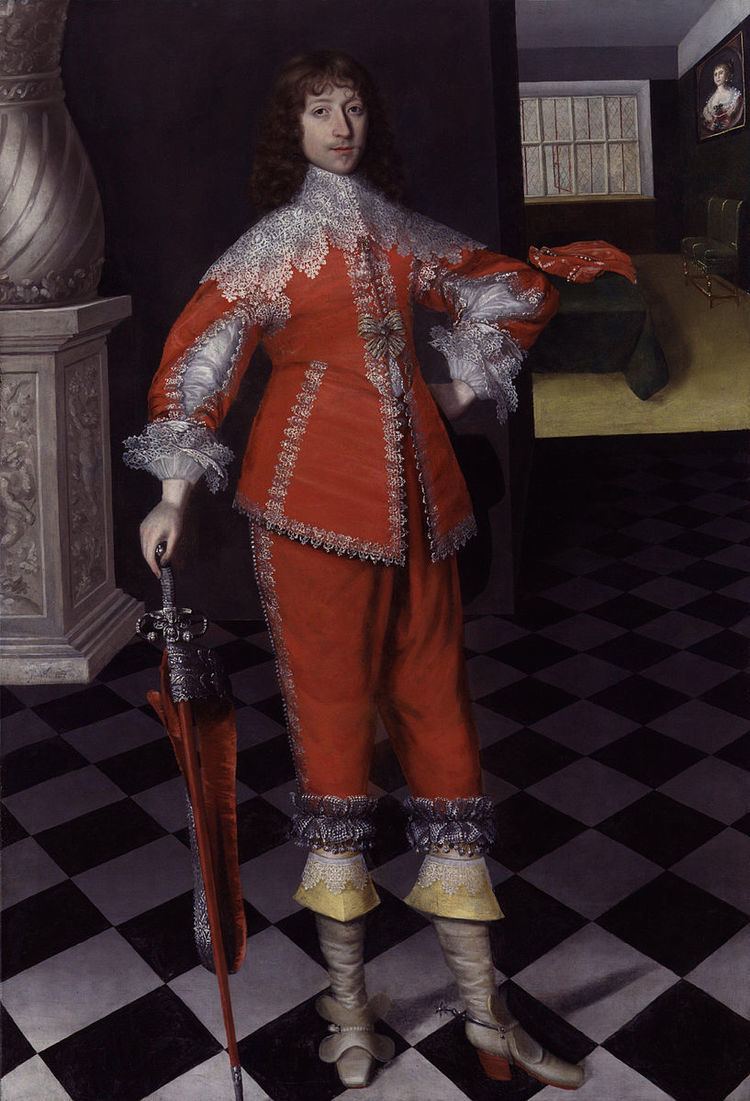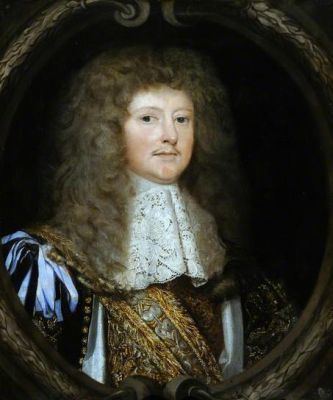Citizenship English Children Honora Belasyse Parents Barbara Cholmley | Name John 1st Nationality English | |
 | ||
Born 24 June 1614Newburgh Grange, Yorkshire ( 1614-06-24 ) Grandparents Henry Cholmley, Margaret Babthorpe Similar People Ferdinando Fairfax - 2nd Lord, William Cavendish - 1st Duke, Edward Montagu - 2nd Earl, Alexander Leslie - 1st Earl of Le | ||
Siblings The Hon. Barbara Belasyse | ||
John Belasyse, 1st Baron Belasyse (or Bellasis) (24 June 1614 – 10 September 1689) was an English nobleman, soldier and Member of Parliament, notable for his role during and after the English Civil War. He suffered a long spell of imprisonment during the Popish Plot, although he was never brought to trial.
Contents

Early life
Balasyse was the second son of Thomas Belasyse, 1st Baron Fauconberg (1577–1652), and Barbara, daughter of Sir Henry Cholmondeley of Roxby, Yorkshire. He was born at Newburgh Grange, and baptised (24 July 1614) at Coxwold, both in Yorkshire. He was MP for Thirsk in the Short and Long Parliaments.
Civil War
Shortly after the start of the Civil War he was "disabled" from sitting in the Long Parliament because he joined the Royalist cause, he raised six regiments of horse and foot soldiers at his own expense, and took part in the battles of Edgehill and Brentford (both in 1642), Newbury (1643), Selby (1644) and Naseby (1645), as well as the sieges of Reading (1643), Bristol and Newark – being wounded several times. He later became Lieutenant-General of the King's forces in the North of England, and Governor of York and of Newark. In Oxford on 27 January 1645 he was raised to the peerage under the title of Baron Belasyse of Worlaby, Lincolnshire.
On 4 February 1665 Samuel Pepys recorded an anecdote about Belasyse's civil war activities in a diary entry:
To my office, and there all the morning. At noon, being invited, I to the Sun behind the Change to dinner to my Lord Bellasses – where a great deal of discourse with him – and some good. Among other at table, he told us a very handsome passage of the King's sending him his message about holding out the town of Newarke, of which he was then governor for the King. This message he sent in a Slugg-bullet, being writ in Cypher and wrapped up in lead and swallowed. So the messenger came to my Lord and told him he had a message from the King, but it was yet in his belly; so they did give him some physic, and out it came. This was a month before the King's flying to the Scotts; and therein he told him that at such a day, being 3 or 6 May, he should hear of his being come to the Scotts, being assured by the King of France that in coming to them, he should be used with all the Liberty, Honour and safety that could be desired. And at the just day he did come to the Scotts.
He told us another odd passage: how the King, having newly put out Prince Rupert of his Generallshipp upon some miscarriage at Bristol, and Sir Rd. Willis of his governorshipp of Newarke at the entreaty of the gentry of the County, and put in my Lord Bellasses – the great officers of the King’s Army mutinyed, and came in that manner, with swords drawn, into the market-place of the town where the King was – which the King hearing, says, “I must to horse.” And there himself personally, when everybody expected they would have been opposed, the King came and cried to the head of the Mutineers, which was Prince Rupert, “Nephew, I command you to be gone!” So the Prince, in all his fury and discontent, withdrew, and his company scattered – which they say was the greatest piece of mutiny in the world.
Interregnum
Belasyse is considered to have been one of the first members of the Royalist underground organisation The Sealed Knot, (as is his predecessor as Governor of Newark: Sir Richard Willis). During the Interregnum, Belasyse was in frequent communication with King Charles II and his supporters in Holland.
Charles II
After the Restoration Belasyse was appointed Lord-Lieutenant of the East Riding of Yorkshire (1660–1673) and Governor of Hull (1661-1673), while from 1665 to 1666 he held the posts of Governor of Tangier and Captain-General of the forces in Africa. According to Samuel Pepys, he accepted the post only for the profit it brought. In 1666/67 Belasyse was in England; his appointment as Governor of Tangier was withdrawn and he was appointed Captain of the Gentlemen-at-Arms. He subsequently (1672) resigned this appointment as he was unwilling to take the Oath of Conformity introduced under the Test Act.
Popish Plot
At the time of the Oates Plot, Belasyse, along with four other Catholic peers, Henry Arundell, 3rd Baron Arundell of Wardour, William Howard, 1st Viscount Stafford, William Herbert, 1st Marquis of Powis, and William Petre, 4th Baron Petre, was denounced as a conspirator and formally impeached in Parliament. Belasyse in particular was said to have been designated Commander-in-Chief of the Popish army, but Charles II, according to Von Ranke, burst out laughing at the idea that this infirm old man, who could by then hardly stand on his feet due to gout, would be able even to hold a pistol. The informer William Bedloe who had once worked for Belasyse, (such first hand knowledge was invaluable to informers, to make their lies sound more plausible) now accused him of ordering the murder, which remains unsolved today, of the respected magistrate Sir Edmund Berry Godfrey. It was never made clear why Belasyse, or indeed any other Catholic, should wish to kill Godfrey, who was notably tolerant in religious matters. Belasyse in his defence referred to his age and ill-health, and reasonably pointed out that under the tolerant rule of Charles II he was living out his last years in comfort: what possible reason had he to wish for a change of regime? The Government, for example, was well aware that the Catholic mass was celebrated regularly at his London house, but made no effort to prevent it.
The most that could plausibly be said against him was that he was a friend of the senior civil servant Edward Colman, an ardent and politically active Catholic, who was executed for his supposed part in the Plot in December 1678, and that Colman had visited Belasyse the night before he gave himself up to the authorities. However Colman in fact seems to have been guilty of nothing more than indiscreet correspondence with the French Court in which he outlined his wildly impractical schemes for the advancement of the Catholic faith in England. There is no reason to think that Belasyse, even if he knew of this correspondence, shared Colman's political opinions.
Despite his frequent references to his old age and infirmity, Lord Belasyse lived on for another ten years. The impeached Catholic peers, though they endured a long imprisonment in the Tower, where Lord Petre died in 1683, were never brought to trial, apart from Stafford, who was executed in December 1680.
James II
Following the accession of James II, Belasyse returned to favour and was appointed a Privy Counsellor in July 1686 and in 1687 was appointed as First Lord Commissioner of the Treasury which, on account of his Catholicism, caused political problems for James II. He and James had always been on friendly terms: James had informally promised to marry Belasyse's widowed daughter-in-law Susan Belasyse after the death of his first wife Anne Hyde. The marriage was forbidden by Charles II who told his brother that "it was too much that he had played the fool once, (i.e. with Anne Hyde) and that it was not to be done a second time."
Private life
From 1671 until his death in 1689, Belasyse lived in Whitton, near Twickenham in Middlesex. Samuel Pepys was impressed by his collection of paintings, which has long since disappeared. He was buried on 14 September 1689 at the church of St Giles in the Fields, London.
Belasyse was married three times, and had children with his first and third wives. His first wife was Jane, daughter of Sir Robert Boteler. His second wife was Anne, daughter of Sir Robert Crane, 1st Baronet, and widow of Sir William Airmine, 2nd Baronet, who died in 1662. His third wife was Anne, daughter of John Paulet, 5th Marquis of Winchester. He had four daughters:
and one son:
Belasyse's son was killed in a duel in 1667 with a Mr Porter and the title passed to his grandson, Henry Belasyse, 2nd Baron Belasyse. The title became extinct upon Henry's own death in 1691. His mother, unusually, was created Baroness Belasyse of Osgodby in her own right. After Charles II firmly vetoed her as a wife for his brother, she remarried James Fortrey. She died in. 1713.
